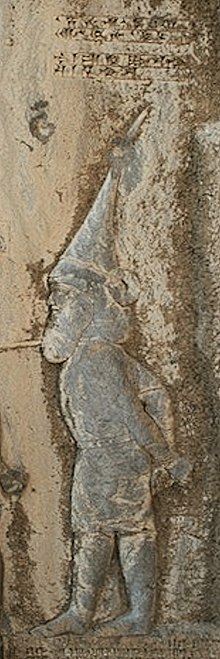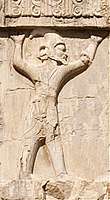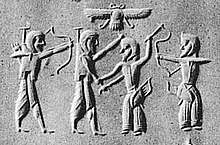Skunkha
Skunkha, also written as Skunxa or Skuka, was king of the Sakā tigraxaudā ("wearing pointed caps Saka,") a group of Scythians, in the 6th century BC.
| Skunkha | |
|---|---|
| King of the Sakā tigraxaudā | |
 | |
| Reign | 6th century BC |
Capture
In 519 BC, Darius I of Achaemenids attacked the Saka tribe and captured their king. His capture is depicted in the relief sculpture of Behistun Inscription, last in a row of defeated "lying kings".[2] After his defeat, Darius replaced him with the chief of another tribe.[3]
King Darius says: Afterwards with an army I went off to Scythia, after the Scythians who wear the pointed cap. These Scythians went from me. When I arrived at the river, I crossed beyond it then with all my army. Afterwards, I smote the Scythians exceedingly; [one of their leaders] I took captive; he was led bound to me, and I killed him. [Another] chief of them, by name Skunkha, they seized and led to me. Then I made another their chief, as was my desire. Then the province became mine.
Related depictions
 The Sakā tigraxaudā are later illustrated among the soldiers of the Achaemenid Empire, as here on the tomb of Xerxes I.
The Sakā tigraxaudā are later illustrated among the soldiers of the Achaemenid Empire, as here on the tomb of Xerxes I. Achaemenid soldiers fighting against Scythians.[4]
Achaemenid soldiers fighting against Scythians.[4]
References
- Behistun, minor inscriptions DBb inscription- Livius.
- Rolle, Renate (1 July 1992). The World of the Scythians. University of California Press. p. 47. ISBN 978-0520068643.
- M. A. Dandamayev (1999). History of Civilizations of Central Asia Volume II: The development of sedentary and nomadic civilizations: 700 BC to AD 250. UNESCO. pp. 44–46. ISBN 978-8120815407.
- Hartley, Charles W.; Yazicioğlu, G. Bike; Smith, Adam T. (2012). The Archaeology of Power and Politics in Eurasia: Regimes and Revolutions. Cambridge University Press. p. 83. ISBN 9781107016521.
